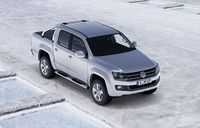Volkswagen Amarok Ready to Take on Dakar Rally
HANOVER, GERMANY – December 29, 2009: With only two days to go before the 2010 Dakar Rally gets underway, a rising crescendo of excitement is gripping the pilots of the 140 or so race cars, the nearly 200 motorcycles and quads and the 50 odd race trucks as well as the hundreds of accompanying individuals also involved in the event. Among the starting field on 1 January will be 35 Amarok. The challenge will take them on a 9000-kilometre tour from Argentina’s capital, Buenos Aires, to Antofagasta in Chile and back.
The Volkswagen Motorsport team – the defending champion – has completed its preparations and is raring to go. The 35 Volkswagen Amarok, some of which will be deployed by the organiser, A.S.O., and some of which will escort the Volkswagen Motorsport team, have passed the technical screening mandatory for all vehicles. “We are thrilled to put the new Amarok through its paces as part of this long-distance challenge, the world’s toughest, before officially launching it on the market,” says Stephan Schaller, CEO of Volkswagen Commercial Vehicles.
Like the pilots of the competing vehicles, the drivers of the escort cars too are eagerly anticipating the start of the rally. While they may not be feeling the pressure of the stopwatch, they will be required to go much the same distance. Setting out from Buenos Aires, the route will take them right across Argentina, over the Andes, to neighbouring Chile. The turning point of the rally will be reached on January 8, when the tour is due to arrive in Antofagasta on the Pacific coast before taking a more southern route back to Buenos Aires, where it will cross the finishing line on 17 January.
The challenge includes navigating the vehicles across the Andes, along mountain passes at an altitude of more than 4,000 metres, as well as through the world’s driest desert, the Atacama Desert, exposing both the vehicles and their crews to extremely gruelling tests.



